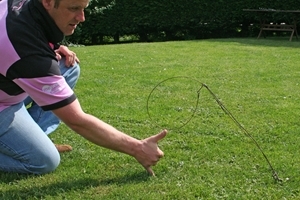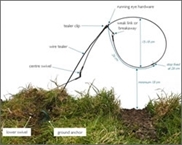Preparation
Ideally your snares should be prepared in such a way that they require minimal handling to set them up. Just prick in the tealer, attach the snare to the anchor, make final adjustments and leave. We colour our snares in bundles temporarily fastened with wire, which avoids them tangling during transport. The more you handle snares between boiling and setting them, the greater the risk of the fox detecting the snare.
Height and dimensions
 A snare loop measuring 9” across by 6” deep (23x15cm) is about right for most circumstances – a larger loop requires less accuracy in placement but is heavy and floppy, and is more likely to catch non-targets. On level ground, the bottom of a loop this size needs to be about 7-7½” (18-19cm) above the ground. On banks this height should be increased because the fox will usually hold its head up to look ahead, not at its feet. You could also increase the loop size slightly in these circumstances to make up for the loss of accuracy. Where badgers are common, the risk of catching them can be reduced by increasing the height of the loop to 8” (20cm) or more above the ground (BASC recommend 9”/23cm). This will have a small negative impact on your fox capture rate.
A snare loop measuring 9” across by 6” deep (23x15cm) is about right for most circumstances – a larger loop requires less accuracy in placement but is heavy and floppy, and is more likely to catch non-targets. On level ground, the bottom of a loop this size needs to be about 7-7½” (18-19cm) above the ground. On banks this height should be increased because the fox will usually hold its head up to look ahead, not at its feet. You could also increase the loop size slightly in these circumstances to make up for the loss of accuracy. Where badgers are common, the risk of catching them can be reduced by increasing the height of the loop to 8” (20cm) or more above the ground (BASC recommend 9”/23cm). This will have a small negative impact on your fox capture rate.
Plant your wire tealer at a slight incline, to one side of the run. Now anchor the swivel end of the snare before you forget, and before making fine adjustments. If necessary, bend the tealer slightly to allow the snare loop to form a natural-looking curve at the right height. If the loop is floppy, you may usefully add
a second tealer of fine florists’ ‘stem’ wire (the uncoated, very malleable stuff) on the opposite side of the run. Prick this lightly into the ground, but only just enough to support the loop, or it will interfere with loop closure. Finally adjust surrounding vegetation to look undisturbed and to disguise the outline of the snare loop. We often like to set the snare beside a long grass stalk, which we use to disguise the snare outline.
Some operators prefer to hang the noose from a longer tealer which arches slightly over the run, so that the eye is quite high (about 11 o’clock or 1 o’clock, taking the snare loop as a clock face). This makes the snare ‘go off ’ like a trap, the noose closing at a light touch under the weight of the cable and running eye. This sensitivity can be a nuisance though: a passing deer or even a breeze may cause the noose to drop and hang there, partially closed and appreciably lower than originally set. In this state it will not catch the fox, but it may catch a badger. The other approach is to have the noose emerge from the top of the tealer, so that the eye is at one side of the noose (ie. 3 o’clock or 9 o’clock–ish; the precise position will depend on how soft or self-supporting the cable is.). The top of the tealer will require a slight bend to make it grade naturally into the curve of the noose. A snare set like this needs a more prolonged tug to make it draw up.
Footwork
While you are setting the snare, stand or crouch in the run itself, but try not to broaden it. Do not stand to one side of the run, as a fox will also diverge from the run to see what you did there, thereby missing the snare. You can put a snare on a track even if you must walk there daily. If you do this, place your feet along the track but close up to the snare on both sides. This keeps the track trodden. If you regularly take a wide step over the snare, foxes too will leap over it. On no account walk round the snare, even when setting it. Foxes have a tendency to follow the easiest path, so if the run is particularly wide, such as along a field edge, use small stones and twigs to subtly guide the fox towards the noose.
Scent
Attention to scent helps enormously. We recommend that you set snares in the morning so that any human scent left on the snare, or at the snare set, has the greatest chance of dissipating before nightfall. Keep water and scent-free soap in your vehicle and wash your hands thoroughly when you first arrive at your snaring site. Before handling or setting snares, but well away from your first snare site, rub your hands with freshly exposed soil (but not from somewhere a fox may have peed, such as a molehill!). This will help to prevent your scent getting onto the snare or surrounding vegetation. To minimise scent, wear rubber boots when setting snares, and keep them clean. Do not kneel in the run when setting the snare - crouch only. Your scent is readily transferred from your trouser knees to the ground, but not from rubber boots. You may find all this concern about scent tedious. We regard it as essential.
Get your FREE fox snaring guide from the GWCT team
Simply enter your email address below to download your essential free guide.
 What's inside your FREE fox snaring guide
What's inside your FREE fox snaring guide
✓ Fox control: Is it important?
✓ What are the alternatives to snaring?
✓ The main components of a well-designed snare
✓ Fox snares: Hardware vs practice
✓ Key controversies
Download free >